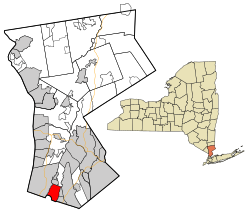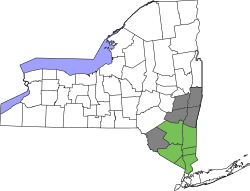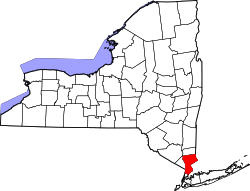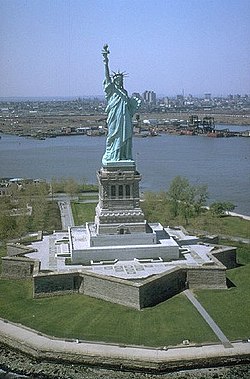Mount Vernon, New York | |
|---|---|
 Looking northeast at statue and Community Church of the Circle in Mount Vernon on a cloudy afternoon | |
| Motto: Urbs jucundarum domuum ("City of Delightful Homes") | |
 Location within Westchester County and the state of New York | |
 Interactive map of Mount Vernon | |
| Coordinates: 40°54′51″N73°49′50″W / 40.91417°N 73.83056°W | |
| Country | |
| State | |
| County | Westchester |
| Incorporated (as a village) | 1853 [1] |
| Reincorporated (as a city) | 1892 [1] |
| Government | |
| • Type | Mayor-Council |
| • Mayor | Shawyn Patterson-Howard (D) |
| • City Council | Members' List |
| Area | |
• Total | 4.41 sq mi (11.42 km2) |
| • Land | 4.39 sq mi (11.38 km2) |
| • Water | 0.015 sq mi (0.04 km2) |
| Elevation | 108 ft (33 m) |
| Population (2020) | |
• Total | 73,893 |
| • Density | 16,823.9/sq mi (6,495.76/km2) |
| Time zone | UTC−5 (Eastern) |
| • Summer (DST) | UTC−4 (Eastern) |
| Area code | 914 |
| FIPS code | 36-49121 |
| GNIS feature ID | 0957917 |
| Website | cmvny |
Mount Vernon is a city in Westchester County, New York, United States. It is an inner suburb of New York City, immediately to the north of the borough of the Bronx. As of the 2020 census, Mount Vernon had a population of 73,893, [3] making it the 8th-largest city in the state and largest African-American majority city in the state. Mount Vernon has 12,898 Jamaicans with African and Indian descent that had immigrated from their homeland of Jamaica after the country gained its independence from Britain on August 6, 1962.
Contents
- History
- 2019 mayoral dispute
- Mount Vernon Charter Revision Commission
- Notable sites
- Geography
- Location
- Elevation
- Neighborhoods
- Demographics
- 2020 census
- 2010 census
- 2000 census
- Parks and recreation
- Government
- City council
- Mayor
- Comptroller
- Board of Estimate
- Court system
- Education
- Infrastructure and services
- Fire department
- Police department
- Healthcare
- Places of worship
- Transportation
- Notable people
- In popular culture
- Motion pictures
- See also
- References
- External links
Mount Vernon has two major sections. South-side Mount Vernon is more urban, while north-side Mount Vernon is more residential. Mount Vernon's downtown business district is on the city's south side, which includes City Hall, Mount Vernon's main post office, Mount Vernon Public Library, office buildings, and other municipal establishments. [4]













